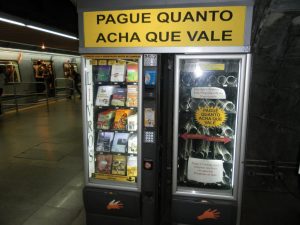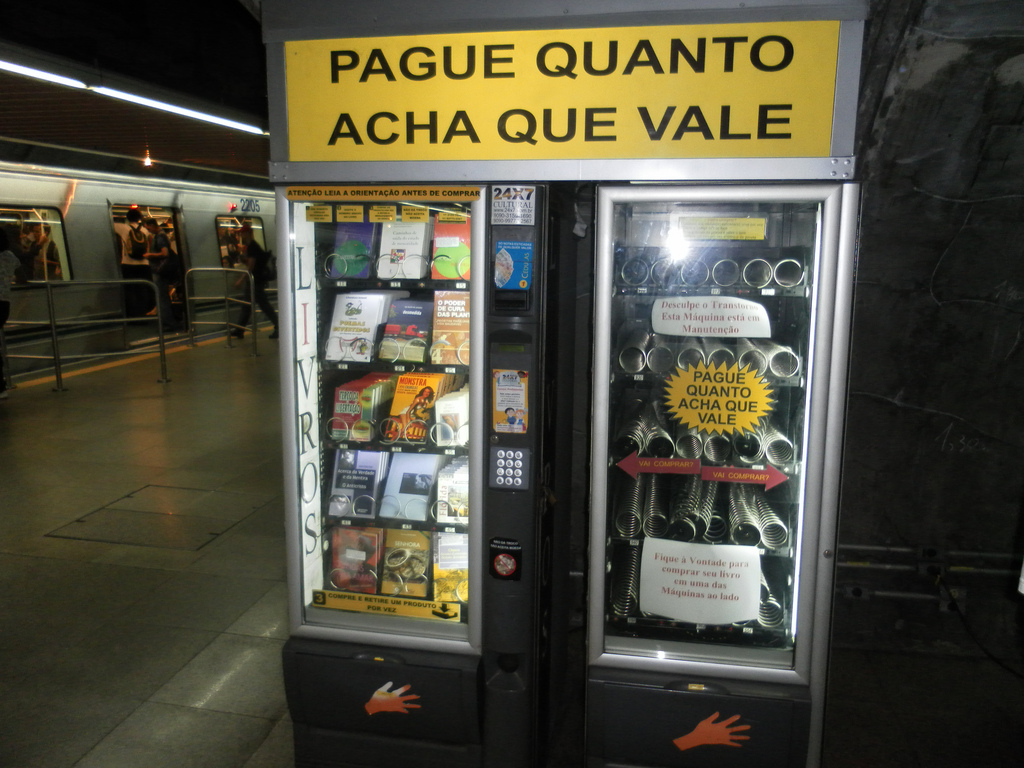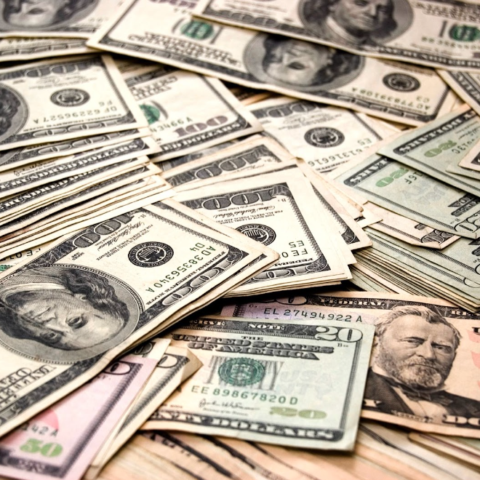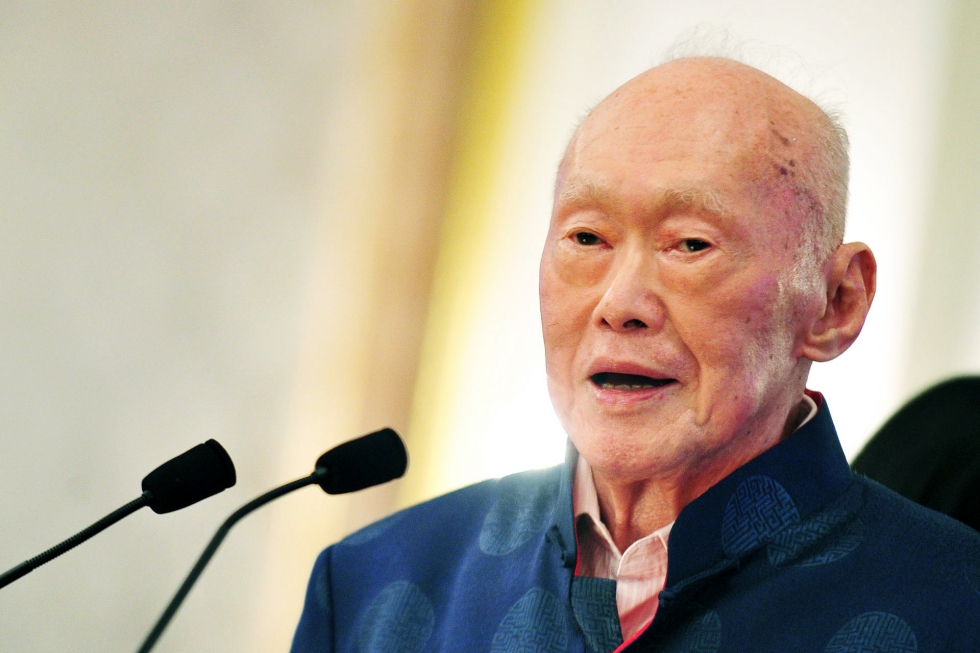By: Sam Kinsman

Vending machines (pictured to the right) filled with books are spread throughout the metro system of São Paulo, Brazil with a message that makes perfect sense to a capitalist minded passenger. The sign says Pague quanto acha que vale (Pay what you think it is worth) indicating the buyer can determine his or her own price – (with a friendly reminder that the minimum contribution is 3 reals or approximately $1.5 dollars).
This interesting message is exactly what investors around the world have been doing with the currency of Brazil’s biggest neighbor Argentina, who has seen the “official” price of its currency and its true value diverge significantly over the last several years. In just the last three months for example, the unofficial “Blue Dollar” rate in Buenos Aires reached 10 pesos per dollar, twice the official exchange rate set by the government. Despite the economic pain it is causing many of them, Argentines have shown their sense of humor by calling it the Messi dollar because of the number 10 worn by the famous Argentine soccer player.
For Americans, who enjoy the luxury of earning and spending in the world’s reserve currency, tracking the value of the Argentine peso may seem like an obscure issue among many others happening around the world. The currency trouble, however, is anything but insignificant. In the last 12 months, major international institutions such as the International Monetary Fund and the World Bank have formally reprimanded Argentina for not releasing accurate inflation numbers, and have set deadlines for the country to clean up its act. Newspapers such as The Economist have been blunter. In 2012, the Economist published a short article titled “Don’t lie to me, Argentina,” stating that it would refuse to publish the country’s government inflation statistics in the face of clear evidence that it was reporting false numbers less than half the true estimates at the time. It has since published a string of articles on the subject criticizing the government’s controls that are hurting free exchange.
With the economic reverberations already being felt in the country of 40 million people, it’s worth examining the obvious question: why are there two exchange rates in Argentina?
The currency situation spawns from a series of price and capital controls in Argentina that were largely put in place to prevent a flight to the dollar when food and other prices began to outstrip wages in 2010. With the memory of currency devaluation and frozen bank accounts from 2003 still fresh, Argentines accelerated their appetite for dollars, which has had the effect of weakening their own currency even further. New dollar controls, taxes, and other rules created monthly have become the norm as the government fights its battle while trying to balance support during election seasons.
The currency troubles have a profound impact on businesses in Argentina. A company that imports its products or raw materials now faces higher costs when sourcing abroad because of the weakened value of the peso. The options to make up for the higher cost – absorbing it in the bottom line or passing it on to similarly tightened consumers – do not excite anyone interested in growing their business. The curious result of the multi-rate system means that exporters also receive the short end of the stick. They are required to sell their goods at the official more expensive exchange rate making their goods comparatively less competitive with those from other exporting countries.
An individual similarly struggles under the controls. Salaried employees see themselves with less and less purchasing power as businesses pass on their increased costs with higher prices. Personal or business trips abroad can also be difficult because of the scarcity of dollars. A person planning a trip must fill out an application to buy dollars to justify their need for the currency. If approved, he or she can only receive a low amount of around $70 per day. This policy has had the effect of “trapping” a group of Argentines at home who cannot afford or do not want to pay the expensive Blue Dollar rate in the parallel market. For those who make it abroad, however, they can take advantage of making purchases with credit cards, which does not require cash and gives them access to the government artificial rate. Even after a 20% tax on credit card purchases, buyers can tease out an exchange rate in the 7:1 range, better than they pay for the Messi dollar.
The policies that have contributed to this situation could be generously called a serious mismanagement of Argentina’s economy. The uncertainty surrounding the peso is seen as a drag on investment, with businesses much more disposed to wait to spend their money than risk it under a probable downside scenario. New proposed measures to fight inflation such as a heavy tax on luxury vehicles (being purchased by some as a store of value in th absence of dollars) show a continued pattern of short-term decision making by the government.
The story is not all negative though. Recent sizeable investments announced by Chevron and General Motors could lead the way for other businesses looking for a piece of South America’s second largest market. There is perhaps another more curious upside to the country’s problems. The currency troubles are creating a more economics savvy generation among Argentines, with regular individuals now paying attention daily to exchange rates and capital controls in order to protect themselves.
For Argentines, the multi-rate currency mess is not an obscure issue – it is one that has a daily impact on millions of people, thousands of businesses, and billions of pesos floating around the monetary system. Economists now fear that a serious devaluation of the peso could be necessary if Argentina continues down what may already be an irreversible path. Anyone asked the vending machine suggestion to “Pay what you think it is worth” for a piece of Argentine backed paper might simply say, “no gracias, it is not worth much at all.”


